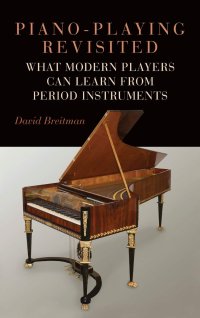
Ebook: Piano-Playing Revisited: What Modern Players Can Learn From Period Instruments
Author: David Breitman Ralph P. Locke
- Series: Eastman Studies in Music
- Year: 2021
- Publisher: University of Rochester Press
- Language: English
- pdf
Today's pianists are expected to play music of three centuries on a single instrument: Steinway's design from the late 1800s. Other types of pianos, such as Mozart's Walter or Chopin's Pleyel, are increasingly being copied or restored, but they are played almost exclusively by specialists in "Historical Performance." David Breitman has been introducing Oberlin Conservatory students to historical keyboards since 1991, and in this book he focuses on the music he cares about most deeply and the problems he has found most perplexing.
He begins by acknowledging the dilemma of confronting historical repertoire with modern instruments, then shows how to apply insights from period instruments to practical problems on any piano, including the relationship between melody and accompaniment and the use of the pedal. The central portion of the book discusses the pianos and piano music of Haydn and Mozart, Beethoven, Schubert, and Chopin, as well as the special place of the clavichord in eighteenth-century keyboard culture. A wide range of musical examples demonstrates how composers were influenced by the instruments they knew, and how that understanding can help today's performers. The book concludes with a passionate plea for individual creativity and autonomy, authentic voices for our own time.
A suite of videos, including demonstrations of representative musical examples as well as of the moderator pedal and clavichord action, can be found here: https://vimeo.com/showcase/8046349.
Table of Contents
Preface
Music Making Then and Now
With Broad Strokes (An Overview)
The Early Days of the Piano: Haydn and Mozart
Beethoven and the Evolving Piano
Schubert
Chopin
The Clavichord
Epilogue: Creativity in the performance of old music
Appendix: Overtone structure of the Steinway and Walter, compared
Glossary of Terms
Notes
Bibliography
Index of Works Discussed in the Text
General Index
He begins by acknowledging the dilemma of confronting historical repertoire with modern instruments, then shows how to apply insights from period instruments to practical problems on any piano, including the relationship between melody and accompaniment and the use of the pedal. The central portion of the book discusses the pianos and piano music of Haydn and Mozart, Beethoven, Schubert, and Chopin, as well as the special place of the clavichord in eighteenth-century keyboard culture. A wide range of musical examples demonstrates how composers were influenced by the instruments they knew, and how that understanding can help today's performers. The book concludes with a passionate plea for individual creativity and autonomy, authentic voices for our own time.
A suite of videos, including demonstrations of representative musical examples as well as of the moderator pedal and clavichord action, can be found here: https://vimeo.com/showcase/8046349.
Table of Contents
Preface
Music Making Then and Now
With Broad Strokes (An Overview)
The Early Days of the Piano: Haydn and Mozart
Beethoven and the Evolving Piano
Schubert
Chopin
The Clavichord
Epilogue: Creativity in the performance of old music
Appendix: Overtone structure of the Steinway and Walter, compared
Glossary of Terms
Notes
Bibliography
Index of Works Discussed in the Text
General Index
Download the book Piano-Playing Revisited: What Modern Players Can Learn From Period Instruments for free or read online
Continue reading on any device:

Last viewed books
Related books
{related-news}
Comments (0)